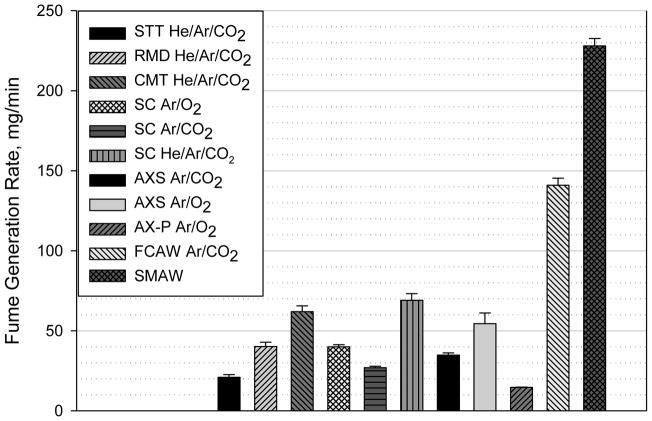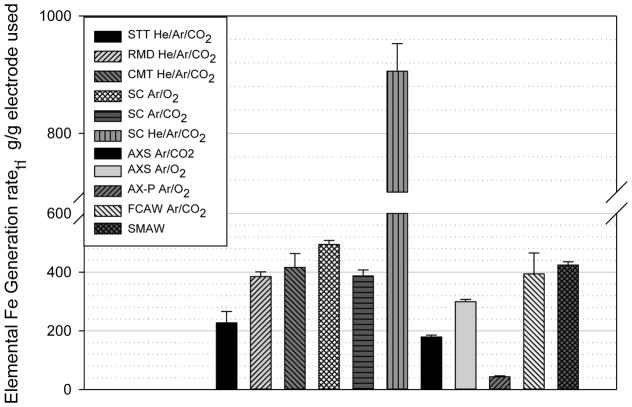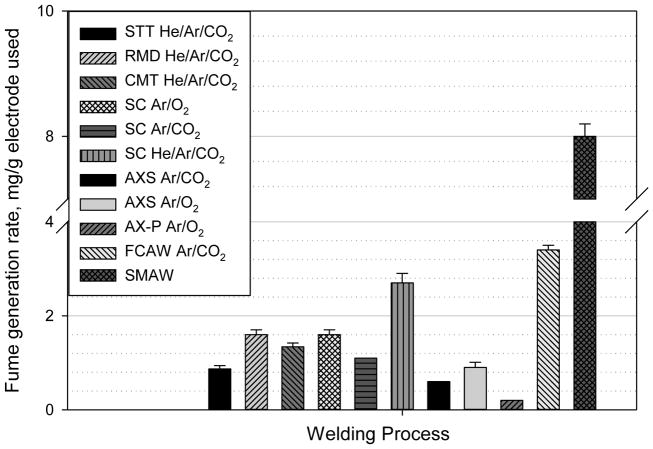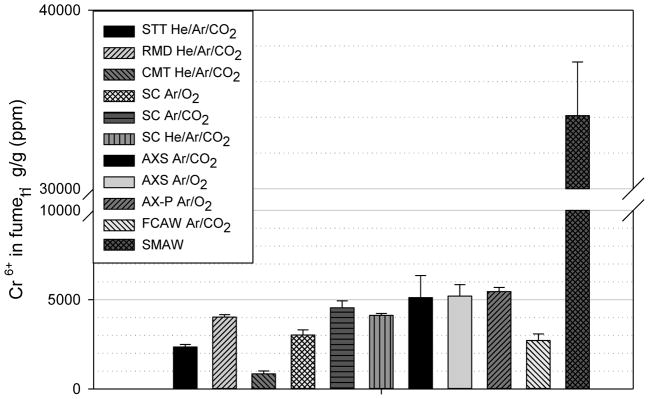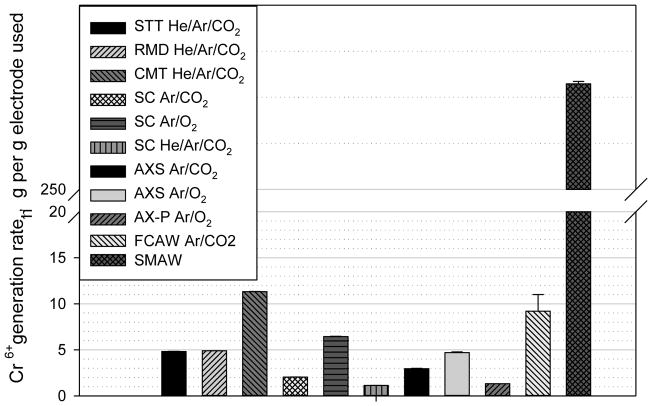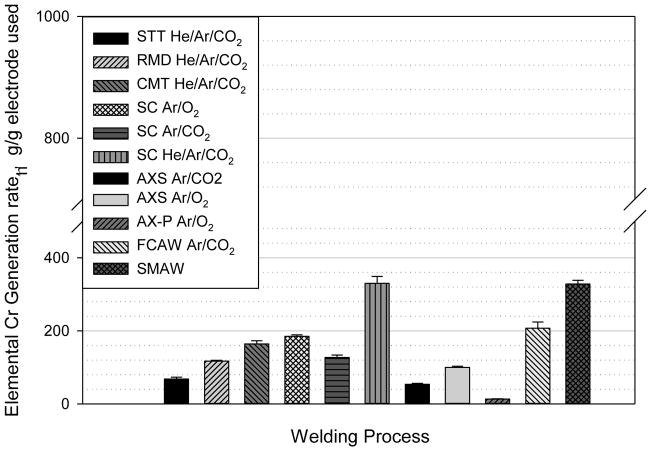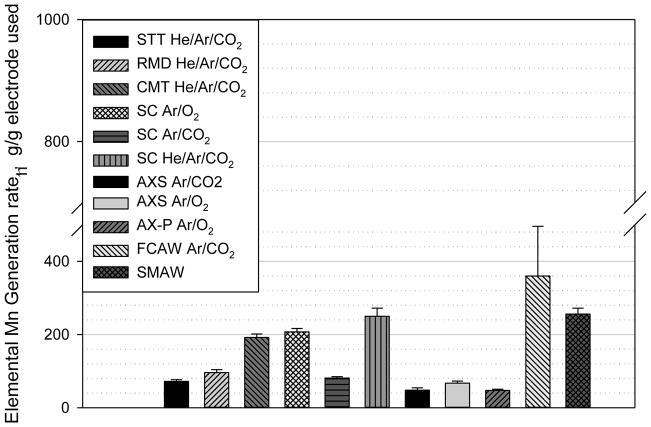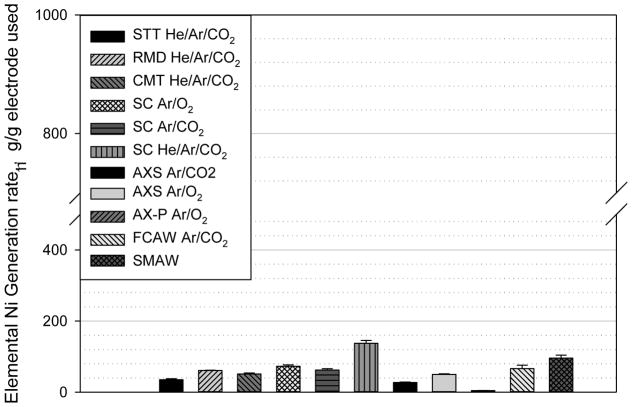Abstract
Nine gas metal arc welding (GMAW) processes for stainless steel were assessed for fume generation rates, fume generation rates per g of electrode consumed, and emission rates for hexavalent chromium (Cr6+). Elemental manganese, nickel, chromium, iron emissions per unit length of weld and labor plus consumables costs were similarly measured. Flux-cored arc welding and shielded metal arc (SMAW) processes were also studied. The objective was to identify the best welding processes for reducing workplace exposures, and estimate costs for all processes. Using a conical chamber, fumes were collected, weighed, recovered and analyzed by inductively-coupled atomic emission spectroscopy for metals, and by ion chromatography for Cr6+. GMAW processes used were Surface Tension Transfer™, Regulated Metal Deposition™, Cold Metal Transfer™, short-circuit, axial spray, and pulsed spray modes. Flux-cored welding used gas shielding; SMAW used E308 rods. Costs were estimated as dollars per m length of a ¼ in (6.3 mm) thick horizontal butt weld; equipment costs were estimated as ratios of new equipment costs to a 250 ampere capacity SMAW welding machine. Results indicate a broad range of fume emission factors for the processes studied. Fume emission rates per g of electrode were lowest for GMAW processes such as pulsed-spray mode (0.2 mg/g), and highest for SMAW (8 mg fume/g electrode). Emission rates of Cr6+ ranged from 50 to 7800 μg/min, and Cr6+ generation rates per g electrode ranged from 1 to 270μg/g. Elemental Cr generation rates spanned 13 to 330μg/g. Manganese emission rates ranged from 50 to 300μg/g. Nickel emission rates ranged from 4 to140 μg/g.
Labor and consumables costs ranged from $3.15 (GMAW pulsed spray) to $7.40 (SMAW) per meter of finished weld, and were measured or estimated for all 11 processes tested. Equipment costs for some processes may be as much as 5 times the cost of a typical SMAW welding machine.
The results show that all of the GMAW processes in this study can substantially reduce fume, Cr6+, manganese and costs relative to SMAW, the most commonly used welding process, and several have exceptional capabilities for reducing emissions.
Keywords: welding fumes, hexavalent chromium, welding costs, fume generation rates, manganese generation rates, nickel generation rates, Gas metal arc welding, flux-cored arc welding, fume emission factors
INTRODUCTION
Welding is a major occupational activity in the US and worldwide, and includes workers in manufacturing, construction and a number of other industrial sectors. In excess of 462, 000 US workers do some welding as part of their duties (1), and worldwide there are over 2 million welders. Welding produces a number of hazards during operation, including physical agents such as extreme heat and ultraviolet radiation, as well as fumes and toxic gases. Antonini (2) reviewed occupationally related adverse health effects in welders, such as lung disease and possible neurological disease. The Work-Related Lung Disease Surveillance Report (3) lists proportionate mortality ratios of 1.58 for pneumoconioses, and 1.21 for lung cancers for welders. Most welding operations are performed on low-alloy or high-carbon steels, but stainless steel may account for up to 5% of welding (4).
Common Welding Configurations
Most welding is done with electrical arc welding processes, although there are more than 80 different welding processes in common use (5). The U.S. Environmental Protection Agency review (6) identified, based on materials usage, that the most prevalently used types of arc welding in the US were shielded metal arc (SMAW or stick welding or manual metal arc welding) ~ 45%; gas metal arc (GMAW), ~34%, and flux-cored arc welding (FCAW) ~17%.
SMAW requires a power supply, an electrode holder, welding rods, and a ground clamp. The welding rods have chemical coating over the filler metal rod that shields the weld to minimize its degradation by atmospheric oxygen or nitrogen. GMAW uses more complex equipment: a power supply, a gas-shielded torch or gun; the electrode is a consumable wire of the desired filler metal fed by a motorized feeder. Shield gases range from the completely inert (argon (Ar), helium (He) and their mixtures) to active gases, which include carbon dioxide (CO2), Ar mixtures with CO2 or oxygen (O2), and other gas mixtures; these gases may have chemical interactions with the weld or fume. FCAW uses equipment similar to GMAW, but the wire electrode has an internal flux material for weld shielding; the process may be used with or without an external shield gas, depending on the specific product.
Metal Transfer Modes in GMAW
In contrast to other arc welding process types, GMAW has more than one mechanism for transferring metal from the electrode into the weld pool. At low applied voltage, the process is called short-circuit GMAW (SC). The end of the electrode wire starts in direct contact with the weld pool, and a portion melts and is transferred into the weld pool. The melting breaks the short circuit, and the arc forms; this may occur up to hundreds of times/sec. When the short circuit breaks, a highly unstable situation causes turbulence in the area around the weld and excess fume and spatter are generated (7). During the short circuit phase, the magnetic field surrounding the wire creates a mechanical force inward, which squeezes the molten wire to a smaller diameter and decreases its cross section, increasing its resistance. At the same time, inductance in the welder tries to keep current at a constant level, and increases the voltage to accomplish that. This is an unstable system with positive feedback which quickly “pinches off” the molten wire, breaks the short circuit and initiates the arc. Several techniques have been developed to tightly regulate pinch-off, including Surface Tension Transfer™ (STT, Lincoln Electric), Regulated Metal Deposition™ (RMD, Miller Electric), and Cold Metal Transfer™ (CMT, Fronius GmbH). STT and RMD precisely control the current until conditions are optimal for transfer of the molten metal drop into the weld pool, and CMT uses a backward wire movement and current control to achieve similar results.
When the shield gases contain high percentages of Ar and the applied voltage is increased, there is a transition to axial spray (AXS) transfer mode. Molten filler metal leaves the electrode wire tip and is transferred as a very fine spray into the weld pool. This produces a high quality weld with lower spatter. The technique is used primarily in flat or horizontal applications; drip problems are a serious limitation for overhead or vertical use. A variation of spray transfer is pulsed spray transfer (AX-P), where current pulses are added to a background current, allowing the total current to periodically exceed the threshold and permit spray mode. This variation allows welds in any position with lower heat input, and a low fume generation rate.
The study objectives were to characterize multiple stainless steel arc welding processes for fume and hexavalent chromium generation rates, and identify the best choices to minimize exposures and costs.
MATERIALS AND METHODS
Operating variables of welding are shown in Table I. Welding was conducted in a 0.6 m diameter, 0.66 m height conical chamber based on an American Welding Society design for a chamber to measure fume generation rates. The test chamber meets the performance criteria of the American Welding Society (8). RMD welding used a leased Miller Pipeworx™ unit; STT welding used a Lincoln 455M welder with a 10M wire feeder/control unit, and CMT used a Fronius TP 2700 welder. A multiprocess welder (Lincoln Electric 350 MP, Cleveland, OH) was used for GMAW SC, AXS, and AX-P modes, as well as SMAW and FCAW. Welding wire was E308LSi, 0.045 in. (1.14 mm) diameter, fed from a 15 kg (33 lb) reel for all GMAW except CMT, which used 0.035 in. (0.89 mm) wire. FCAW used 308LT0-1 0.045 in. (1.14 mm) diameter wire, while SMAW used E308L-16 3/16 inch (4.8 mm) rods.
Table I.
Operating conditions for welding in the study
| Process | Shield gas | Wire feed rate mm min−1 [in min−1] | Travel rate mm min−1 [in min−1] | Voltage (Volts) | Current (Amperes) |
|---|---|---|---|---|---|
| Surface Tension Transfer® (STT) | He/Ar/CO2 90/7.5/2.5% | 3050 [120] | 360 [14] | 19 | 215 peak |
| Regulated Metal Deposition® (RMD) | He/Ar/CO2 90/7.5/2.5% | 3175 [125] | 380 [15] | 19 | 90–100 |
| Cold Metal Transfer® (CMT) | He/Ar/CO2 90/7.5/2.5% | 5840 [230] | 380 [15] | 14–20 | 130–140 |
| Short-Circuit (SC) | Ar/O2 99/1% | 3175 [125] | 360 [14] | 15.5 | 125 |
| Short-Circuit (SC) | Ar/CO2 99/1% | 3175 [125] | 360 [14] | 15.5 | 125 |
| Short-Circuit (SC) | He/Ar/CO2 90/7.5/2.5% | 3175 [125] | 360 [14] | 19.5 | 110 |
| Axial Spray (AXS) | Ar/CO2 99/1% | 7620 [300] | 510 [20] | 25 | 240 |
| Axial Spray (AXS) | Ar/O2 99/1% | 7620 [300] | 510 [20] | 24.5 | 220–250 |
| Pulsed Spray (AX-P or GMAW-P) | Ar/O2 98/2% | 7620 [300] | 510 [20] | 0.9 V trim | 175 |
| Flux-cored (FCAW) | Ar/CO2 75/25% | 6350 [250] | 635 [25] | 26 | 160 |
| Shielded Metal Arc (SMAW) | - | 3580 [141] | 360 [14] | 20 | 125–150 |
Shield gas was taken from cylinders at a flow rate of 19 liters/min. The welding material in the baseplates was ½ inch (12.7 mm) thick type 304 stainless steel, 22 inch (56 cm) diameter disks; plates were degreased and stainless-steel wire-brushed before welding. Initial conditions for all welding types used manufacturer’s recommendations. All welding operations were optimized for good bead appearance with good penetration of the baseplates, good toe wetting and no undercut, as evaluated by M.K. and S.S. If welds were unsatisfactory using initial conditions, travel rates and currents were altered until satisfactory welds were obtained. Baseplates were rotated at the desired rotary speed to provide a travel rate compatible with good welds. A commercial welding turntable was modified for external control by Labview (National Instruments, Austin, TX) program; rotary speed was detected by an encoder on the output shaft and the travel rate controlled continuously during operation. Welder operation was initiated and ended by program control to precisely control arc time.
Shield gases were selected based on welding consumable manufacturer’s recommendations for US welders, but the helium tri-gas mixture would not be used in most of the rest of the world due to the unavailability of helium. Welding conditions for all processes studied are listed in Table 1.
Sampling Strategies
Fumes from the weld area were sampled at the top of the chamber through a 102 mm filter at 200 liters/min. The filter material was Hollingsworth and Vose (East Walpole, MA) electrostatic medium (PE 13060NA), cut to 102 mm diameter. The flow was measured with a mass flow meter (TSI, Shoreview, MN) before sampling. After sampling was completed, filters were removed from the housing, folded inward, weighed to the nearest 0.1 mg and put in sealed anti-static polyethylene bags.
Sample Recovery and Processing
Recovery and processing of collected fume has been described in detail in earlier studies (9). Briefly, fume was recovered from the filters by gentle suction onto a polycarbonate filter and homogenized and ground in a metals-free vial. The apparatus used a disposable 13 mm diameter x 25 mm long polyethylene vial with two 3.2 mm (1/8 inch) silicon nitride- coated ceramic balls, shaken for 30 sec. in a Wig-L-Bug grinder. After grinding, the material was anti-static treated again, and transferred to 20 ml scintillation vials with PTFE-lined caps. Storage in the vials was at room temperature, in air, and vials remained sealed unless samples were removed for analysis; a previous study (10) indicated that samples were stable after 3 months storage using this procedure.
Analysis for Cr 6+
For Cr 6+ analysis, 5.0 mg samples from the recovered fume samples were anti-static-treated and weighed into 15 ml centrifuge tubes and treated and analyzed using NIOSH Physical and Chemical Analysis Method 7605, Hexavalent Chromium by Ion Chromatography (11). The estimated limit of detection is 0.02 μg, and the method range is 0.05 to 20 μg of Cr6+. Five ml of extraction solution (3% Na2CO3/2% NaOH) were added to each 5 mg sample, and the tubes sonicated in a bath for 30 minutes. Samples were removed and centrifuged for 15 minutes at 2500 x g. The supernatant was transferred to 25 ml volumetric flask and diluted with H2O. Samples were analyzed by ion chromatography using a Dionex HPIC-AS7 column with 250 mM (NH4)2SO4/100 mM NH4OH mobile phase and a postcolumn reagent (2.0 mM diphenylcarbazide/10% methanol/1N H2SO4) with absorbance detection at 540 nm. Four concentrations of standards were made from a certified hexavalent chromium solution, covering a range of 0.4–4 μg/ml.
For metals analysis, 5.0 mg samples were weighed into 15 ml centrifuge tubes, and 3 ml of ultrapure HNO3 (Optima, Fisher Scientific, Pittsburgh, PA) were added, the tube vortexed, and poured into 55 ml PTFE digestion tubes (CEM, Matthews, NC). The process was repeated with 3ml then 4 ml, bringing the total to 10 ml in the digestion tubes. The PTFE tubes were sealed and heated 20 min at 200 C in a CEM MARS microwave digester (CEM, Matthews, NC), cooled, and the contents transferred to 25 ml volumetric flasks. After filling to 25 ml with 18 MΩ – cm H2O and mixing, samples were diluted 1:100 with 18 MΩ – cm H2O, mixed and analyzed at Bureau Veritas (Novi, MI) for Mn, Ni, Fe, and Cr by the Perkin-Elmer Optima 3200XL inductively-coupled atomic emission spectrometer.
RESULTS
Results are shown below in Figures 1–9; all results are presented as means of 4 replicate welding runs with the error bars representing the standard error of the means. Total fume generation rates are shown in Figure 1; results range from 15 (AX-P) to 230 mg/min (SMAW). In order to allow comparison of processes on an equal basis, however, fume generation rates need to be normalized with respect to the electrode feed rates used. The normalized generation rate is related to a welder’s exposure for any given weld, since the time for weld completion decreases as the electrode feed rate increases. The results normalized for electrode (wire) feed rates were calculated as the product of the generation rate and the reciprocal of the wire feed rate in g/min, and are shown in Figure 2. An example calculation for STT: [21 mg fume/min * (1 min/120 in wire) * (39.37 in/m) * (1 m wire/7.97g wire) =0.9 mg fume/g wire]. The SMAW rod consumption rate was converted to a wire feed rate by relating the masses consumed per unit time, after measuring the arc times, rod lengths and rod density. Some studies relate results to amounts of metal deposited rather than consumed; data for percentages of metal deposition are often provided by welding consumables suppliers to allow that computation.
Figure 1.
Total fume generation rates expressed as mg fume per min for 11 processes.
Abbreviations: STT, Surface Tension Transfer; RMD, Regulated Metal Deposition; CMT, Cold Metal Transfer; SC, short-circuit, AXS, axial spray; AX-P, pulsed axial spray; FCAW Flux-cored arc welding; SMAW, shielded metal arc welding,
Figure 9.
Elemental Fe generation rates for 11 processes, expressed as μg Fe per g of electrode consumed.
Figure 2.
Total fume generation rates expressed as mg fume per g of electrode consumed for 11 processes.
Results for Cr6+ content in the fume are shown in Figure 3, expressed as μg Cr 6+/g fume; results are the mean of 3 replicate samples. Generation rates of Cr 6+ are shown in Figure 4, and are calculated as the product of the fume generation rate in mg/min and the fraction of Cr6+, expressed as μg Cr 6+ per minute. [e.g., for STT: 21 mg/min * 2349 E-6 *1000 μg/mg=49 μg Cr 6+/min]. Normalized Cr 6+ generation rates are shown in Figure 5, and are calculated as the product of the normalized fume generation rate in mg fume/g electrode and the fraction of Cr6+ in ppm [for STT:0.9 mg fume/g wire * 2349 E-6 *1000μg/mg=2.1 μg Cr 6+/g electrode].
Figure 3.
Cr6+ content in fume expressed as μg Cr 6+ per g fume (ppm).
Figure 4.
Cr6+ generation rates for 11 processes, expressed as μg Cr6+ per minute.
Figure 5.
Cr6+ generation rates for 11 processes, expressed as μg Cr6+ per g of electrode consumed.
In addition to fume generation and normalized fume generation rates, generation rates of specific metals are also important for estimating exposures and health risks. This information also removes the non-metal components of welding fume, such as fluxes from SMAW and FCAW processes, which are major constituents of welding fume for those processes. Figures 6, 7, 8 and 9 display the normalized generation rates of elemental chromium, manganese, nickel and iron for each process in terms of μg metal per gram of welding electrode. Calculations are based on the product of the normalized fume generation rate (mg/g) and the fraction of fume due to the specific metal (mg/mg).
Figure 6.
Elemental Cr generation rates for 11 processes, expressed as μg Cr per g of electrode consumed.
Figure 7.
Elemental Mn generation rates for 11 processes, expressed as μg Mn per g of electrode consumed.
Figure 8.
Elemental Ni generation rates for 11 processes, expressed as μg Ni per g of electrode consumed.
Relative costs of welding process choices
Computation of costs for various processes was done on a relative basis. Costs were in 3 areas: consumables, labor, and equipment. Consumables would include welding rods and wire, shield gases, and other items such as contact tips and nozzles. Labor costs would include not only actual welding time, but also preparation, scaling, re-welding, etc., and are often computed as cost per linear ft. of completed weld. Labor costs included wages, benefits and contractor’s overhead; the total was $50.00 per hr. Since some welds require multiple passes, such as a root pass as well as multiple fill passes, cost comparisons need to be done on the same types of welds. Equipment costs are much more difficult to compute, since the welding equipment may be acquired, financed, and depreciated in many different ways, or can often be leased.
Costs were computed on a boiler repair that required 50 m of horizontal butt weld on ¼ inch type 316 stainless steel. The job was divided into 4 equal lengths, and 4 separate welding processes were done and labor and consumables costs were computed for each. Measured costs were: $7.40/m. (55%labor/45% consumables) for SMAW, $3.40/m (25% labor/75% consumables) for FCAW, $3.18/m. (29% labor/71% consumables) for GMAW SC and $3.15/m (28% labor/72% consumables) for Pulsed-spray GMAW. Estimated costs for other processes are shown in Table II, based on calculations. Since costs are estimated per linear m of completed weld, data for fume and Cr6+ emissions are also presented after normalization by linear travel rates in the same Table. Equipment costs range (low to high) from SMAW to GMAW and FCAW to pulsed GMAW; the complex-waveform processes (STT, RMD, and CMT) are the most expensive; these capabilities are usually available only on dedicated units or top-of-the line models. Typical equipment cost ratios are (for 250 ampere capacity welding machine; SMAW= 1.0): GMAW ~1.74; GMAW-pulsed ~2.1; STT ~2.9; RMD ~3.5 and CMT ~4.9, but these types of comparisons are at best imperfect due to the vastly different features, etc. of available welders.
Table II.
Fume generation rates, normalized fume generation rates, and costs per linear m. of weld and fume generation rates in mg fume/linear m. for 11 welding processes
| Process | Fume Generation Rate (FGR) (mg min−1) | Normalized FGR (mg g−1) | Cost ($ m−1) | FGR (mg m−1) | Cr6+ GR (μg m−1) |
|---|---|---|---|---|---|
| Surface Tension Transfer | 21 | 0.9 | 4.50* | 60 | 140 |
| Regulated Metal Deposition | 40 | 1.6 | 4.20* | 110 | 430 |
| Cold Metal Transfer | 62 | 1.3 | 4.20* | 160 | 140 |
| Short circuit Ar/O2 | 40 | 1.6 | 4.50* | 110 | 340 |
| Short circuit Ar/CO2 | 27 | 1.1 | 4.50* | 80 | 350 |
| Short circuit He/Ar/CO2 | 69 | 2.7 | 4.50* | 190 | 790 |
| Axial Spray | 35 | 0.6 | 3.18 | 70 | 350 |
| Axial Spray | 55 | 0.9 | 3.18 | 110 | 560 |
| Pulsed Spray | 15 | 0.2 | 3.15 | 30 | 130 |
| Flux-cored | 141 | 2.8 | 3.41 | 220 | 620 |
| Shielded Metal Arc | 228 | 8 | 7.41 | 630 | 22000 |
estimated
DISCUSSION
Results showed a wide range of fume generation rates, from 15 mg/min for pulsed spray to 230 mg/min for SMAW, a 1:15 ratio overall. Normalized rates had a 40:1 range, spanning 0.2 (AX-P) to 8 mg fume/g electrode (SMAW). Fume generation rates and normalized rates were generally comparable or slightly higher than those found in similar studies, such as the US EPA review (6) and Yoon et al. (12). The chamber used in this study was highly efficient, with a measured loss of fume to the interior of the chamber < 1% of the collected mass for a given run(9). Substantial masses of large (>10 μm and > 18 μm) fractions in a Multiple-Orifice Uniform Deposit Impactor sampler were also seen (data not shown), which are easily lost in less efficient systems. Results were also normalized for emissions per m of completed weld to easily compare with costs, since the cost data were already calculated in term of $/m of completed weld. The range for these emissions was from 630 (SMAW) to 30 mg/m (AX-P), a 22:1 ratio overall. By any of these measures, any of the GMAW processes would be a major improvement relative to SMAW, the most commonly used welding process.
Generation rates for Cr6+ showed similar trends, with emission rates ranging from 7800 (SMAW) to 50 μg/min (STT), a ratio exceeding 150:1. The normalized ratio was about 250:1, from 270 (SMAW) to 1 μg/g (CMT). The results normalized per meter of finished weld spanned 22000 (SMAW) to 125 μg/m (AX-P), a 175:1 ratio. Results were in good agreement from earlier studies, with the complex-waveform processes highly favorable options for reducing Cr6+ emissions in the workplace. These trends are also in agreement with field study measurements from this laboratory (9). Again, by any of the presented measures there are major reductions in Cr6+ by using any of the GMAW processes relative to SMAW.
Elemental metals results were also wide-ranging, with elemental Cr rates ranging from 330 (SMAW) to 13 μg/g (AX-P); this would include chromium metal as well as Cr in any oxidation state. Manganese results were similar, spanning 360 (FCAW) to 47 μg/g (AX-P). Nickel results were low, spanning 137(SC using He/Ar/CO2) to 4 μg/g (AX-P).
This study used methods and approaches of an earlier study on mild steel (MS) welding (13). Although that study found no quantifiable Cr6+, the results for fume, normalized fume and some metals were comparable to the results in this study. Total fume in stainless steel (SS) welding ranged from 1 to 230 mg/min, while MS rates were 4–390 mg/min. Normalized rates of fume generation ranged from 200–8000 μg/g electrode for SS processes, and 70–12600 μg/g for MS. Manganese generation rates were also similar, ranging from 50–360 μg/g electrode for SS processes, and 80–460 μg/g for MS. Nickel results were very low but also similar; 4–100 μg/g for SS and 4 to 90 μg/g for MS. Due to the high boiling point (3003 K) and enthalpy of vaporization (379 KJ/mol) for nickel, there is probably a limit to Ni in the vapor phase that is lower than that of the other metals when considering liquid-vapor equilibrium. In general, the same types of processes produced similar rankings for both MS and SS processes; SMAW and FCAW were the highest emitters, and AX-P, CMT, STT and RMD were low emitters of fume, manganese and nickel.
This study used process/shield gas combinations that were recommended by consumables and equipment manufacturers and were the most popular choices for the US welding market. Helium mixtures, however, are not widely available in much of the world at reasonable cost. While this somewhat limits the conclusions of this study, substitution of typical argon mixtures with CO2 or O2 would probably lower fume and hexavalent chromium emissions further, based on observations in our laboratory that are not included in this study; we hope to further study such combinations.
Cost ranges were not as extreme as the emissions, but several GMAW processes and FCAW were less than half of the labor/consumables cost of SMAW. The weld used for cost determination was as single-pass weld for SMAW; it is common for welds using SMAW to need more than one pass, while many GMAW and FCAW welds are single-pass operations; this would make those alternatives even more advantageous relative to SMAW.
Selecting a welding process
While Table 2 and the Figures show the various costs and generation rates for fumes and metals, the choices are not as simple as choosing the method with the lowest generation rates for the hazardous agent of interest. First, it is imperative that the welding process selected be able to produce a competent weld for the specific task. In some cases, there may be severe limitations on what processes can be used, such as in power plants or nuclear facilities. Certain welds may have a single specified process for certification, and alternatives may not have been researched. Some welding techniques have limitations on thicknesses of the welds, or the welding unit may have special input power requirements, such as three-phase-only power. After eliminating unsuitable choices, the group of the best processes to minimize the problem of highest priority can be selected. Analysis of costs will further narrow the possibilities. Cost estimates may be significantly different, depending on how the equipment is acquired or leased, but the cost estimates for labor and consumables presented in Table 2 are sufficient for comparing alternatives.
Barriers to Change
In general, most welding engineers and welders will not be eager to change welding processes. Engineers are reluctant to take risks on new ways of welding. Most welders have completed testing and certification for multiple types of SMAW applications, and are familiar with problems and solving those problems, while they may not be as well trained and experienced for GMAW and similar processes. The work sequence is also different when changing from SMAW to any of the GMAW techniques. A typical SMAW pattern would be to prepare the area for welding, weld until the rod is consumed, put down the electrode holder, and chip off the slag from the weld, inspect the weld and prepare any questionable areas for re-welding. They would then mount a new rod and repeat the sequence. GMAW work patterns would typically include preparation and then welding continuously as long as the torch cable can reach, unless other physical barriers are present. This sequence may result in more fatigue, especially for vertical and overhead positions. Some training and testing may be necessary, but most GMAW processes, including AX-P, are not especially difficult to learn or use, and welders are often receptive to demonstrations from other welders or welding equipment company representatives.
Conclusions
For minimizing fume generation rate, fume generation rate per g of wire, and Cr6+generation rate per g of electrode, there are several exceptional choices shown in this study, including Cold Metal Transfer™, pulsed spray GMAW, STT™ and other GMAW types. Cold Metal Transfer™, pulsed spray, Surface Tension Transfer™ and Regulated Metal Deposition™ have multiple practical advantages besides low total fume generation rates; they are usable in any position, have low heat input that minimizes warping, and have labor costs per weld significantly lower than SMAW. While there will be situations where they may not be suitable, all would be good choices in many applications, especially where fume may be difficult to reduce by local exhaust ventilation or similar measures. Compared with SMAW, the most commonly-used welding type, any of the GMAW processes examined in this study have a substantial advantage with respect to fume or Mn reduction. Several GMAW processes also have substantial cost advantages.
Acknowledgments
The authors would like to thank Wesley Doneth and Mike Ludwig from Fronius USA for the generous loan of the CMT welder, and Doug Dunbar and colleagues at Lincoln Electric for arranging background information and brief training for STT welding.
Footnotes
Disclaimer
The findings and conclusions in this paper are those of the authors and do not necessarily represent the views of the National Institute for Occupational Safety and Health. The mention of any company names or products does not imply an endorsement by NIOSH or the Centers for Disease Control and Prevention, nor does it imply that alternative products are unavailable, or unable to be substituted after an appropriate evaluation.
Contributor Information
Michael Keane, Email: mjk3@cdc.gov, National Institute for Occupational Safety and Health, Health Effects Laboratory Division, 1095 Willowdale Rd. Morgantown, WV 26505.
Arlen Siert, Xcel Energy, Denver CO.
Samuel Stone, National Institute for Occupational Safety and Health, Health Effects Laboratory Division, 1095 Willowdale Rd. Morgantown, WV 26505.
Bean T. Chen, National Institute for Occupational Safety and Health, Health Effects Laboratory Division, 1095 Willowdale Rd. Morgantown, WV 26505
References
- 1.Bureau of Labor Statistics, U.S. Department of Labor. Welding, soldering, and brazing workers. [Accessed 11/20/2014];Occupational Outlook Handbook. 2006–07 [Online] at http://www.bls.gov/oco/ocos226.htm.
- 2.Antonini JM. Health Effects of Welding. Crit Rev Toxicology. 2003;33(1):61–103. doi: 10.1080/713611032. [DOI] [PubMed] [Google Scholar]
- 3.NIOSH. Work-related Lung Disease Surveillance Report. DHHS (NIOSH); Cincinnati, OH, USA: 2007. Publication Number 2008–143a. [Google Scholar]
- 4.IARC. Monographs on the evaluation of carcinogenic risks to humans, Volume 49: Chromium, nickel, and welding. Lyon; France: 1990. [PMC free article] [PubMed] [Google Scholar]
- 5.NIOSH. DHHS (NIOSH) Publication No. 88–110. Cincinnati, OH: 1988. Criteria for a Recommended Standard: Welding, Brazing, and Thermal Cutting. or available at: http://www.cdc.gov/niosh/topics/hexchrom/ [Google Scholar]
- 6.U.S. Environmental Protection Agency. Chapter 12: Metallurgical Industry. [Accessed 11/20/2014];AP 42, Section 12.19: Development of Particulate and Hazardous Emission Factors for Electric Arc welding. 2009 [Online] at http://www.epa.gov/ttn/chief/ap42/index.html.
- 7.Althouse A, Turnquist C, Bowditch W, Bowditch K, Bowditch M. Modern Welding. Tinley Park, IL: 2004. [Google Scholar]
- 8.American Welding Society. Laboratory Method for Measuring Fume Generation Rates and Total Fume Emission of Welding and Allied Processes (AWSF1.2:2006) American Welding Society; Miami, FL: 2006. [Google Scholar]
- 9.Keane M, Siert A, Stone S, Chen B, Slaven J, Cumpsten A, Antonini J. Selecting processes to minimize hexavalent chromium from stainless steel welding. Welding Journal. 2012;91(9):241–246S. [PMC free article] [PubMed] [Google Scholar]
- 10.Keane M, Stone S, Chen B, Slaven J, Schwegler-Berry D, Antonini J. Hexavalent Chromium content in stainless steel welding fumes is dependent on the welding process and shield gas type. J Env Mon. 2009;11:418–424. doi: 10.1039/b814063d. [DOI] [PubMed] [Google Scholar]
- 11.NIOSH Analytical Methods Manual. [Accessed 11/20/2014];Method 7605, hexavalent chromium by ion chromatography. (4). available at: http://www.cdc.gov/niosh/nmam/default.html.
- 12.Yoon SY, Paik NW, Kim JH. Fume generation and content of total chromium and hexavalent chromium in flux-cored arc welding. Ann Occ Hyg. 2003;47:671–680. doi: 10.1093/annhyg/meg063. [DOI] [PubMed] [Google Scholar]
- 13.Keane M, Siert A, Chen BT, Stone S. Profiling mild steel welding processes to reduce fume emissions and costs in the workplace. Annals of Occupational Hygiene. 2014;2014:1–10. doi: 10.1093/annhyg/meu007. [DOI] [PMC free article] [PubMed] [Google Scholar]



